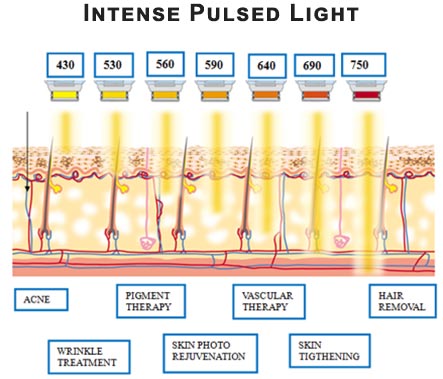Intense Pulsed Light

New York dermatologists have used a cosmetic treatment with great success, called intense pulse light therapy or IPL. While not as cutting edge as the latest laser surgery being touted as the best way to alter your appearance with little or no aftereffects, IPL is a valuable tool your dermatologist has in his box of non-invasive techniques to treat your skin. Since its inception in the late 1990s, intense pulsed light technology has evolved even more than its original state and now is used just as frequently as lasers — sometimes even more often — because of the low rate of risks and side effects it offers.
Its high-intensity pulses of light are ideal for treating:
- Lines and wrinkles on your face
- Sunspots and freckles
- Unwanted hair
- Lesions that are vascular in nature, such as:
- Rosacea
- Spider angiomas — benign overgrowths of blood vessels on your skin
- Port-wine stains
Pulsing Light Technology
Intense pulsed light also is referred to as flashlamp therapy and follows many of the same principles used by laser therapy. It sends beams of light directly into your damaged skin cells. The light turns into heat and damages the targeted cells. Certain colored targets, called chromophores, absorb the light. Instead of burning the cells like the high beam of a laser, IPL instead uses various color wavelengths to treat specific areas. IPL systems rely on a set of filters to refine the treatments. The filters reduce the need to heavily target every cell and focus on the chromophores that your NYC dermatologist wants to alter. Intense pulsed light is a non-ablative procedure.
This means that the light is directed at the lower layer of skin, called the dermis, and doesn’t remove or damage the epidermis or top layer of your skin. While this technique doesn’t always give you the dramatic results that ablative therapies do, you have minimal, if any, downtime from the procedure and no lingering signs. You could visit your Manhattan dermatologist on your lunch hour to receive an IPL treatment and go right back to work with no one the wiser.
Various Wavelengths
There are several different IPL wavelengths, each designed to treat specific skin disorders. For example, the IPL wavelength designed to treat vascular lesions targets the red pigments in your blood. The red pigment itself can be destroyed this way without damaging any other tissue or surrounding skin. Melanin is targeted with a different wavelength used to treat age spots and pigmented birthmarks that lie flat on your skin. Hair removal utilizes the melanin wavelength that aims its light at your hair follicles. Because this machine is sensitive to color, it’s most useful on dark hair and doesn’t work as effectively on light hair. HOWEVER, the IPL is so non-invasive that it’s safe to use on your arms, face, bikini lines, chest, back, and legs, really anywhere you want to get rid of dark hair.
Preparing for the Procedure
As with any cosmetic dermatological treatment, your medical skin specialist will explain how the IPL works and what you can expect from each treatment. You should go into any cosmetic therapy with realistic expectations because teach treatment may not produce the level of results you were hoping for. Additionally, your dermatologist in NYC needs to give you an exam, including medical history, to discover any underlying causes for your skin disorder that must be addressed before you can begin. You’ll be asked to avoid exposure to ultraviolet rays either from the sun or a tanning booth for one month before one month following treatment.
IPL in the Office
The treatments are straightforward and shouldn’t take more than about 20 minutes per treatment. Treatment includes the following steps:
- You may be given a topical anesthetic to numb the affected area, but most people don’t need that.
- You’re asked to wear protective eyewear so that you don’t accidentally look at the light.
- A cooling gel is applied to your skin.
- The IPL has a smooth glass surface; it’s rubbed against your skin on the affected area.
- You can leave as soon as the treatment is complete.
- To get the results you expect, you will likely require a series of treatments spaced 1 month apart.
You’ll feel very little if any pain. IPL is one of the most painless facial rejuvenation techniques you can get. Some say it feels like a rubber band has snapped your skin or that it’s been given a quick pinch.
Possible Side Effects
Side effects do exist, but they’re rare. Potentially, you may experience:
- Bruising; this happens to about 10 percent of the patients who undergo IPL therapy
- Hair loss that you didn’t expect or necessarily want to be removed
- Slight pinkish discoloration and soreness on the spot where the IPL was focused
- Pain during the procedure, as reported by some people with low thresholds for discomfort; topical anesthesia can address this issue
- Blistering also can happen if your skin pigment absorbs too much light
- Redness and peeling are similar to a sunburn, which may last for no more than a couple of days
- Dark or light patches may appear if your pigment cells are damaged during the procedure, but they typically go away and rarely are permanent
- Rare scarring that also recedes in time
Important Reminder: This information is only intended to provide guidance, not definitive medical advice. Please consult dermatologist NYC about your specific condition. Only a trained, experienced board-certified dermatology doctor or pediatric dermatologist could determine an accurate diagnosis and proper treatment.
Locations: Manhattan Dermatology (Upper East Side) 983 Park Ave, Ste 1D1, NY 10028(212) 427-8750 Manhattan Dermatology (Midtown) 56 W 45th St, Ste 819, NY 10036
(212) 889-2402 Manhattan Dermatology (Union Square) 55 W 17th St, Ste 103, NY 10011
(212) 378-9984

